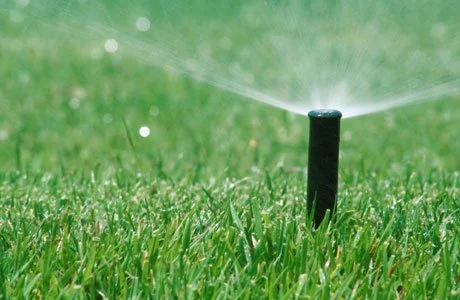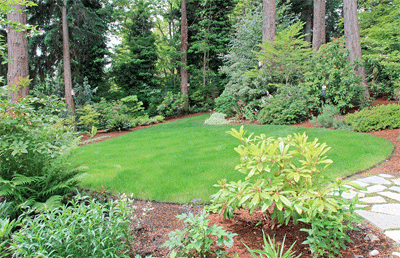Follow these tips for a healthy lush green lawn:
There are few things as tranquil as walking across a healthy lush green lawn, there is simply nothing quite like it. These tips will help your lawn flourish into the envy of the neighbourhood.
Service equipment: Keep your equipment serviced and your blades sharp:

Many think maintaining garden equipment is unnecessary or too much of a hassle, but most don’t realise the consequences of dull lawnmower blades. When the lawn is mowed with dull blades the lawn isn’t as much cut as it is torn or ripped. This results in a bruise on the leaf blade rather than a cut resulting in the leaf blade dyeing back from the wound. This makes the lawn appear dull and brown for some time after mowing and means that the lawn will take longer to recover struggles to thicken.
Mowing right: Many people mow their lawn too short:

A good tip to make your lawn appear more lush and healthy is to mow your lawn slightly higher, the longer leaf blades disguise unappealing patches in the lawn. As a norm refrains from cutting more than one-third of the current height. This will encourage your grass to develop deeper roots which make for a stronger plant. A Longer lawn also results in the more natural shade which reduces evaporation and improves soil quality
Leave lawn clippings after mowing:
Plenty a gardener will tell you this is a sin as it forms thatch which deters water and air movement, but in actual fact damaging thatch is caused by other conditions. The truth is leaving a thin layer of clippings on the lawn after mowing will result in them decomposing and adding organic matter to the soil hence replenishing your lawn. If thatch is a problem scarify your lawn during late winter or early spring and aerate it by poking holes into the lawn with a garden fork or lawn aerator.
Water correctly:

By watering your lawn correctly you don’t only encourage a stronger plant with a deeper root system, but you save water and thus money. The best practice is to water the lawn less frequently and to apply more water at a time, this way the water seeps deeper into the soil allowing the top crust to dry out which forces the roots to develop and grow deeper in search of water.
Another tip to a healthier, lusher lawn is to water in the morning rather than the evening or warmer parts of the day. Watering in the morning will result in minimal evaporation allowing the water to soak into the soil and benefit your lawn. Also if the lawn is watered too late in the day it may become susceptible to fungal diseases throughout the night.
Further, save water and gather the nutritious alternative which is rainwater. Install a rain barrel to your gutter system to further cut costs and benefit your lawn.
Fertilising:

Generally, the lawn should be fertilized from spring until autumn and much less during winter. It is said that chemical fertilisers produce quicker results, but that organic fertilisers improve soil quality rather than boost the plant itself. Whichever you choose it is vital that the dosage and application instructions are followed attentively as an improper application of fertilisers almost always does more harm than good. Always remember to water well after applying fertilisers to avoid your grass being “burnt” by the fertiliser. Good lawn fertiliser has higher Nitrogen and Potassium levels (These are first and third of the three numbers typically found on.
Smaller lawns make for easier maintenance:

Larger lawns are not only more expensive to maintain, but they drink a lot of water meaning they are harsher on the environment and don’t allow for as much attention to detail. One way of reducing your lawn is by adding more garden beds. Plant fast-growing indigenous trees and perennials. These will require less water and maintenance and they will attract wildlife to the garden while they add some colour and much-needed shade which shields your garden from evaporation.
Sow seed into bear patches and level the surface:

There are few things as an eyesore as a bare brown patch in the lawn. Cultivate bare patches by tilling the surface and adding some compost and bone meal, level the surface with a rake and remove any clumps. Evenly sow the seed over the surface, lightly cover and carefully firm the seed into place. Water well after sowing and only mow once well established. In time this will form a uniform lawn and help deter weeds.
For a Healthy Lush Green Lawn Keep The Following In Mind
- Soil Aeration: Aeration is vital for maintaining a healthy lawn. It involves making holes in the lawn to allow air, water, and nutrients to penetrate the soil, promoting deeper root growth and improving drainage. This can be done using a spike aerator or a plug aerator, ideally in the spring or autumn when the lawn is actively growing.
- Grass Type Selection: Choosing the right grass type for your climate and soil is crucial. Understanding your local climate and soil type helps in selecting a grass variety that will grow well and require less maintenance.
- Lawn Disease Prevention: Preventing lawn diseases starts with good cultural practices like proper watering, mowing, and fertilization. Keeping the lawn healthy reduces the likelihood of disease. Regular monitoring and early intervention are key to controlling outbreaks.
- Weed Management: Effective weed management includes both preventive measures, like maintaining a healthy lawn, and reactive approaches, such as hand weeding or using natural herbicides. It’s important to address weeds before they spread, as they compete with grass for nutrients and water.
- Adjusting Mowing Height by Season: Changing the mowing height throughout the year can protect your lawn. In the summer, keeping grass a bit taller provides shade to roots and helps retain soil moisture. In spring and autumn, a shorter cut encourages growth and reduces leaf wetness, minimizing disease risk.
- Proper Fertilization Techniques: Proper fertilization involves applying the right type of fertilizer at the right time and in the right amount. Use a balanced fertilizer in the spring and autumn, and ensure even application to prevent burn spots. Over-fertilizing can harm the lawn and the environment.
- Regular Lawn Inspections: Regularly inspecting your lawn helps in early detection of problems like pest infestations, diseases, or nutrient deficiencies. Quick action can prevent minor issues from becoming major problems.
- Optimal Watering Practices: Watering your lawn properly is key. It’s best to water deeply and infrequently to encourage deep root growth. Early morning watering reduces evaporation and disease risk. Adjust your watering schedule based on weather conditions and soil type.
- Seasonal Lawn Care Routine: A seasonal lawn care routine involves different activities throughout the year, like fertilizing in spring and autumn, aerating in the spring, dethatching as needed, and adjusting watering and mowing practices with the changing seasons.
- Organic Lawn Care Practices: Organic lawn care focuses on natural methods like using compost as a fertilizer, employing organic weed control measures, and introducing beneficial organisms to combat pests. It’s environmentally friendly and sustainable.
- Creating a Balanced Ecosystem: Encouraging a balanced ecosystem in your lawn involves promoting beneficial insects and microorganisms that naturally keep pests in check. Planting diverse flora and using natural lawn care products can help create a healthier, more balanced outdoor environment.


